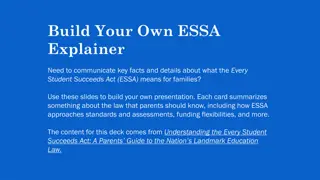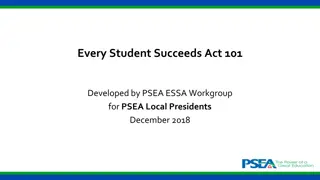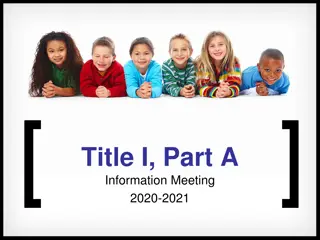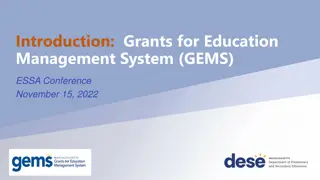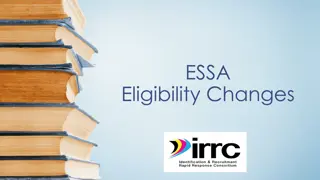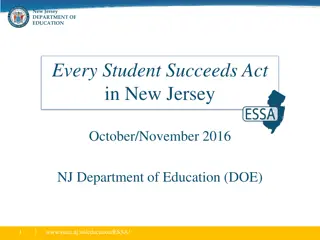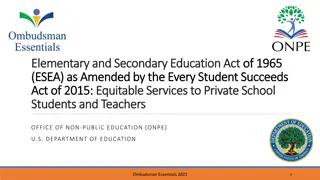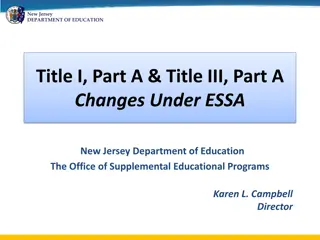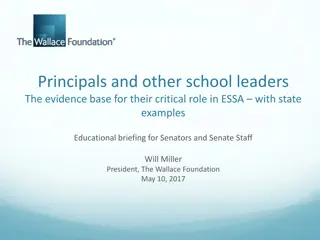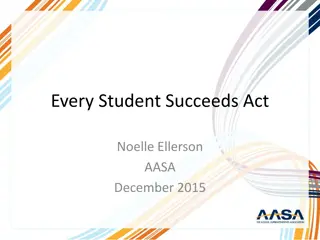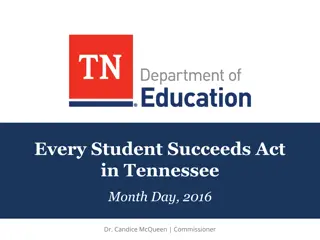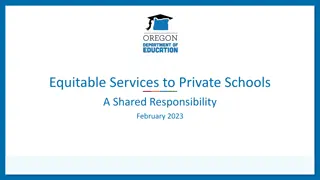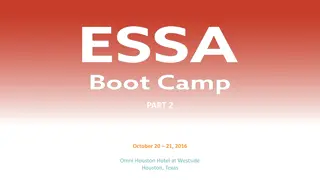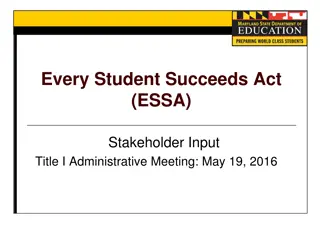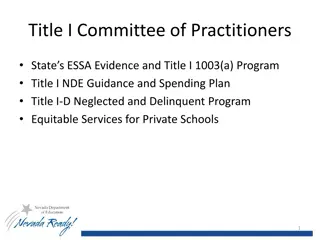Equitable Services Requirements and Guidelines under ESSA
Equitable Services Requirements and guidelines under ESSA outline the responsibilities of education officials, ombudsman, and private school administrators to ensure fair distribution of federal funds. The ESEA Team in Maine works to uphold Title I, Part A, Migrant Education, Teacher Quality, English Learners, Student Support, and Academic Enrichment programs. The regulations can be found in various statutes and regulations such as 34 CFR 200.62 and ESSA Section 1117. Applicable non-regulatory guidance documents provide additional insight on fiscal changes and equitable services requirements. The roles and responsibilities of an Ombudsman include serving as a resource for LEAs and private school officials, and resolving complaints related to equitable services. Certain types of Non-public schools in Maine are approved to receive equitable shares of federal funds.
Download Presentation

Please find below an Image/Link to download the presentation.
The content on the website is provided AS IS for your information and personal use only. It may not be sold, licensed, or shared on other websites without obtaining consent from the author. Download presentation by click this link. If you encounter any issues during the download, it is possible that the publisher has removed the file from their server.
E N D
Presentation Transcript
Providing Equitable Services Under ESSA Provided by the Maine ESEA Team 1
ESEA Team o Chelsey Fortin-Trimble, ESEA & Title I Director o Jackie Godbout, Title I Consultant o Charles Lomonte, Title II Coordinator & State Ombudsman o April Perkins, Title III Coordinator o Travis Doughty, Title IV Coordinator & SIG Coordinator o Daniel Weeks, Title V Coordinator & Title I Data Specialist o Tyra Corson, ESEA Management Analyst 2
Equitable Services Requirements o Title I, Part A Sec. 1117 o Title VIII Sec. 8501 Title I, Part C - Migrant Education Title II, Part A - Teacher Quality Title III, Part A English Learners Title IV, Part A - Student Support & Academic Enrichment Title IV, Part B - 21st Century Community Learning Centers 3
Where are the requirements? Statutes and Regulations 34 CFR 200.62 200.67 (Regulations) ESSA Section 1117 and 8501 (Statute) EDGAR Sections 76.650 76.677 (Regulations) 4
Where are the requirements? Applicable Non-Regulatory Guidance Fiscal Changes and Equitable Services Requirements under ESEA, as amended by ESSA, November 21, 2016 https://www2.ed.gov/policy/elsec/leg/essa/essaguidance160477.pdf Title IA Private School Services to Eligible Students, October 17, 2003 [Items B21-B56] http://www.ed.gov/programs/titleiparta/psguidance.doc Ensuring Equitable Services to Private School Children: A Title I Resource Tool Kit, September 2006 https://www2.ed.gov/programs/titleiparta/ps/titleitoolkit.pdf 5
Roles & Responsibilities of an Ombudsman Serve as a general resource regarding equitable services requirements for both LEAs and private school officials under Titles I and VIII, which may include conducting initial outreach to define the contours of the ombudsman s responsibilities. The ombudsman also should serve as the primary point of contact for responding to and resolving any complaints regarding equitable services that the SEA receives under its ESEA complaint procedures. 6
Types of Non-public Schools in Maine Non-Public Schools NOT APPROVED for the Equitable Shares of Federal Funds Non-Public Schools APPROVED for Equitable Shares of Federal Funds Recognized Non-public Schools Approved Regular Private Schools Non-traditional Limited Purpose Private Schools Approved Special Purpose Private Schools For-Profit Non- Public Schools 7
Discussion Topic What impact does the provision of equitable services have on your schools? 8
Transferability of Funds Sec. 5103 Funds may be transferred from: Funds may be transferred into: Title I, Part A Title I, Part D Title II, Part A Title II, Part A Title IV, Part A Title III, Part A Title IV, Part A Title V, Part B 9
Delivery of Equitable Services Sec. 1117(a)(5); Sec. 8501(a)(2) Directly, through private company, or another LEA May be on-site at private school Services must benefit students and not the school itself Neutral, secular, and non-ideological (Section 8505) 10
Suggested Timeline for Delivery of Equitable Services Inform private school officials Identify needs Evaluate services Spring (Previous Year) Summer Spring Fall/Winter Timely and meaningful consultation Provide services, programs, materials, or resources 11
Equitable Services Title I, Part A Sec. 1117(a)(1)(A) Services must benefit students and not the private schools (34 CFR section 76.658) Services, may include: Special educational services; Instructional services (including evaluations to determine the progress in meeting such students academic needs); Counseling or Mentoring; Materials; One-on-one tutoring; Other benefits under Title I (such as dual or concurrent enrollment, technology, equipment, etc.) 12
Equitable Services Title I, Part A Sec. 1117(a)(1)(A) The LEA designs and implements the Title I program based on the consultation and obligates the funds, using LEA school staff or third party contractor Staff must meet teacher certification for grade level and area to be taught; contracted staff do not Program services must be provided to identified students and begin at the same time as the Title I program for public school students Materials may be purchased to support the implementation of the program services Students services at the private school must be in a pullout situation 13
Equitable Services Title II, Part A LEA may continue to use Title II, A funds to Provide professional development for teachers, principals, and other school leaders to address the specific needs of the students PD Includes allowable activities under Title II, A: As long as the cost is allowable (Section 2103(b)(3)) The cost meets the specific needs of students enrolled in private schools and not the school itself (34 CFR 76.658) It ensures the LEA is responsible and maintains control of funds (Section 8501(d)) 14
Title II Equitable Services All things Professional Development and Teacher Quality New Learning/Training vs. Work to do New Learning Work to do Allowable Not Allowable 15
Equitable Services Title II, Part A Multiple Pathways to Teaching and Learning Transformative School Leadership Induction and Mentorship Teachers AND Admin Meaningful Evaluation and Support Strong Teacher Leadership 16
Equitable Services Title III, Part A Purpose of Title III funds is to develop new EL programs and/or improve and enhance existing EL programs through: family engagement professional development supporting student achievement Supplement, not supplant If you are required by law to do it, Title III funds cannot be used for it. 17
Equitable Services Title III, Part A An LEA is responsible for providing equitable services and benefits to eligible private school students, their teachers, and other educational personnel under Title III, in order to meet the language needs of ELs enrolled in private schools. An LEA, or any other direct or indirect recipient of Federal financial assistance, is subject to Title VI of the Civil Rights Act of 1964. 18
Equitable Services Title IV, Part A Purpose of Title IV, Part A is to improve students academic achievement by increasing capacity to: Provide all students with access to a well-rounded education; Improve school conditions for student learning by supporting safe and healthy students; and Improve the effective use of technology in order to improve the academic achievement and digital literacy of all students 19
Well-Rounded Education Opportunities Sec. 4107 Academic Enrichment Science, Technology, Engineering, and Math (STEM) Civics & Government Education Geography Instruction Music and Arts Environmental Education Foreign Language Instruction College and Career Counseling Accelerated Learning Programs (including exam fees for low income students) Volunteerism and Community Involvement Integrating Multiple Disciplines (i.e. programs that combine arts and math, music and literacy, etc.) Traditional American History 20
Safe and Healthy Students Sec. 4108 Safe and Supportive Schools Student Physical and Mental Health Preventing Bullying & Harassment School Dropout Prevention School Readiness Reducing Exclusionary Discipline Suicide Prevention Building School/Community Relationships Re-entry and Transition Services for Justice Involved Youth Substance Abuse Prevention Violence Prevention School-based Health & Mental Health Services Nutritional Education Trauma-Informed Classroom Management Chronic Disease Management Cross Cutting Topics Mentoring and School Counseling Schoolwide Positive Behavioral Interventions 21
Effective Use of Technology Sec. 4109 Provide personalized learning Discover, adapt and share high-quality resources Implement blended learning strategies (i.e. formal education programs that leverage technology- based and face-to-face instructional approaches) School-wide and district-wide approaches to inform instruction and support teacher collaboration 22
Effective Use of Technology Sec. 4109 Technology Infrastructure - 4109(a)(2)(B): Computer devices, equipment, software applications, etc. Special Rule 4109(b): LEAs may not spend more than 15% of the SSAE funds used for technology on technology infrastructure 23
Required Use of Funds $30,000 or more Sec. 4106 If an award amount (including transfers) is greater than $30,000, the LEA must do all of the following: Allocate at least 20% of funds for Well-rounded Education Allocate at least 20% of funds for Safe & Healthy Students Allocate portion of funds for Effective Use of Technology* *Special Rule: No more than 15% of the project budget can be used for infrastructure (computer devices, software, etc.) 24
Required Use of Funds $30,000 or more Sec. 4106 LEAs must also, within their Comprehensive Needs Assessment (CNA), examine the needs for improvement in: Access to, and opportunities for, a well-rounded education for all students School conditions for student learning in order to create a healthy and safe school environment Access to personalized learning experiences supported by technology and professional development for the effective use of technology 25
Required Use of Funds Under $30,000 Sec. 4106 If an award amount (including transfers) is less than $30,000, the LEA must do at least one of the following: Allocate at least 20% of funds for Well-rounded Education Allocate at least 20% of funds for Safe & Healthy Students Allocate portion of funds for Effective Use of Technology* *Special Rule: No more than 15% of the project budget can be used for infrastructure (computer devices, software, etc.) 26
Cross-Cutting Requirements Sec. 4106 LEAs must prioritize the distribution of funds to schools served by the LEA based on one or more of the following: Have the greatest need, as determined by the LEA Have the highest number or percentage of children counted under Title I, Part A Are identified for comprehensive support & improvement Have consistently underperforming student subgroups Are identified as a persistently dangerous public school 27
Cross-Cutting Requirements Sec. 4105; Sec. 4110; Sec. 4106 No more than 2% of Title IV, Part A award (including transfers) can be used for direct administration of Title IV, Part A All funds awarded under Title IV, Part A (including transfers) may only be used to supplement and not supplant other federal, state, and local funding that would be made available for IV-A activities LEAs must annually report to the State how funds are being used to meet the requirements of Title IV, Part A and the results of an evaluation in the effectiveness of Title IV, Part A activities in meeting the LEAs proposed outcomes 28
Prohibited Uses of Funding Sec. 4001; Sec. 8526 Funds may not be used to: 1. Provide medical, drug treatment, or rehabilitation services, except for integrated student supports, specialized instructional support services, or referral to treatment for impacted students, which may include students who are victims of, or witnesses to, crime or who illegally use drugs; 2. Develop or distribute materials, or operate programs or courses of instruction directed at youth, that are designed to promote or encourage sexual activity; 29
Prohibited Uses of Funding Sec. 4001; Sec. 8526 3. Provide sex education or HIV-prevention education in schools unless that instruction is age appropriate and includes the health benefits of abstinence; 4. Operate a program of contraception distribution in schools; 5. Construct, renovate, or repair of any school facility, except as authorized under this Act; or 6. Provide transportation, unless otherwise authorized under this Act. 30
Allocation Process Sec. 4105 SEA makes formula awards to LEAs Formula awards bear the same relationship to the amount of funding the LEA received under Title I, Part A in the preceding fiscal year Example: PineRSU received $500,000 (or 1%) of the $50,000,000 awarded in Title I funds by the Department last year, meaning PineRSU is eligible for 1% of the Department s Title IV, Part A funding this year 31
Allocation Process Sec. 4105 Section 4105(a)(2) sets a statutory minimum allocation of $10,000 per LEA In situations where states lack sufficient funding to issue each LEA within the state a $10,000 Title IV, Part A award, all awards must be ratably reduced in order to comply with Section 4105(b) Example: SEA has $1.843M in funds for 187 LEAs. SEA does not have enough money to issue all LEAs $10,000 or more. SEA divides $1.843M by 187 and gets $9,855.61. SEA adjusts all formula allocations (up or down) to result in a $9,855.61 award for all LEAs 32
Allocation Process Sec. 4105 Due to final federal allocations, FY18 Title IV, Part A allocations required ratable reductions for all LEAs across the state, meaning each eligible LEA received the same $9,855.61 Title IV, Part A allocation (NEW) Final federal allocation for Title IV, Part A increased by 175% from FY18 to FY19 FY19 Title IV, Part A allocations will follow a slightly different formula than in FY18 with many eligible districts seeing increases in Title IV, Part A funding 33
Consultation Sec. 1117(a)(1)(A) & (b); Sec. 8501(c) (NEW) The goal of all parties should be to reach an agreement on how to provide equitable and effective programs for eligible private school children LEA must provide timely and meaningful consultation with appropriate private school officials The SEA recommends individual consultation meetings with each private school 35
Consultation Sec. 1117(b)(3); Sec. 8501(c) Timely Before the LEA makes any decisions During the design and development of the program Meetings shall be on-going throughout implementation and assessment of services Annual Requirement A simple letter explaining the intent of the Title I program is not enough ED suggests invitation to meeting to explain 36
Consultation Sec. 1117(b)(3); Sec. 8501(c) Meaningful Genuine opportunity for parties to express their views EDGAR 76.652 Views of private school must be seriously considered The LEA should initiate consultation with a proposal for services and must hear the view of private school. Final Decision is made by the LEA after consultation 37
Consultation 38
Consultation Title I, Part A Key areas of program development identifying eligible students, determining their needs, developing programming, evaluating program Who will deliver program services LEA personnel or through third party contractors/agencies Agreement or disagreement of services and written justification for any disagreement Pooling or consolidated use of funds rarely used provisions Equitable share service obligation amounts are determined by the State and must be adjusted by the LEA when funds are transferred into Title IA 39
Consultation - Title III, Part A How the needs of eligible ELs, their teachers, and other educational personnel will be identified The services that the LEA will provide to meet the language development needs of identified ELs, as well as the professional development needs of their teachers and other educational personnel at the school who work with ELs Whether services will include initial identification of ELs and assessment of their language proficiency How and when the LEA will make decisions about the delivery of Title III services, including consideration of the views of the private school officials on the provision of contract services through potential third-party providers 40
Consultation - Title III, Part A As part of timely and meaningful consultation, the LEA and private school officials should discuss whether the private school wishes to have its eligible ELs, their teachers, and other educational personnel receive Title III services and, if so, how its students will be identified as ELs. 41
Assessment Identification: An LEA is responsible for ensuring that private school students are appropriately identified as ELs and cannot require a private school to administer an ELP assessment as a condition for a private school s ELs to receive equitable services under Title III. Progress: Title III does not require an LEA to administer the State s annual ELP assessment for ELs in private schools. However, MEA operational procedures require that all publicly funded ELs be administered ACCESS for ELLs annually until exiting. 42
Consultation - Title IV, Part A Timely and meaningful consultation before determining any use(s) of funding Discuss needs, goals, benchmarks, etc. for ensuring successful implementation of Title IV, Part A program activities Total allocation to LEA must follow the percentage rules for Title IV, Part A content areas Non-public equitable shares are counted as part of public LEAs allocation for purposes of meeting Title IV, Part A activity category percentage requirements 43
Consultation - Title IV, Part A Example: $50,000.00 Title IV, Part A allocation Public LEA Non-Public LEA Consultation Process 90% enrollment 10% enrollment Both parties must to work together to determine how the needs of all students can be met through Title IV, Part A programming $45,000.00 (90%) $5,000 (10%) Physical & mental health priority STEM education priority 44
Disagreement Sec. 1117(b)(2); Sec. 8501(c) (NEW) If an LEA disagrees with the views of private school officials with respect to any topic subject to consultation, The LEA must provide, in writing, to such private school officials the reasons why the LEA disagrees Final decision rests with the LEA 45
Written Affirmation Sec. 1117(b)(5); Sec. 8501(c) LEAs must obtain written affirmation that timely and meaningful consultation occurred (NEW) LEAs must also give option of signing a written affirmation indicating that timely and meaningful consultation did not occur or that the program design is not equitable with respect to eligible private school children 46
Non-Public Participation Form Affirmation of Consultation I agree that this school has been consulted IN A TIMELY AND MEANINGFUL MANNER in the planning of the consolidated ESEA application and equitable share percentage. If no, see your right to file a complaint below. The Ombudsman will also follow-up with the LEA. ___Yes ___No Date of Consultation Method of Consultation 47
Non-Public Participation Form If participating in any title funds noted above, the Agreement on Consultation for the SEA Ombudsman must be completed. This school has been consulted and is satisfied with the program design and educational services to be offered within each of the participating Title programs. If no, see your right to file a complaint below. ___Yes ___No ___NA If there was any disagreement between the LEA and the non-public school, did the LEA provide in writing the reasons why the LEA disagreed? If no, the non-pubic school should request this correspondence. The Ombudsman will also follow up with the LEA. ___Yes ___No ___NA 48
Equitable Service Formula Title I, Part A Per-pupil basis The amount available is based on the number of poverty students in the public Title I schools and the number of poverty students in the private schools that would attend a public Title I school 49
Title I Per Pupil Equitable Shares RSU 99 TITLE I PUBLIC SCHOOL POVERTY COUNT PRIVATE SCHOOL POVERTY COUNT PER PUPIL AMOUNT [TOT POV COUNT / TI ALLOC] TOTAL PRIVATE SCHOOL SHARES PRIVATE SCHOOL SAU ASSOCIATION TOTAL POVERTY COUNT TITLE I PUBLIC SCHOOLS PRIVATE SCHOOLS TI DISTRICT ALLOCATION Green School Private School A RSU 99 100 2 $ 2,440 Private School A RSU 99 Blue School 100 5 $ 6,100 Hanover Private School Orange School 200 AOS 50 3 $ 3,660 400 10 410 $ 500,000 1,220 $ 12,200 50




